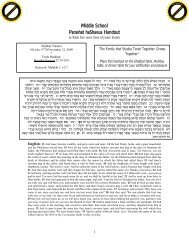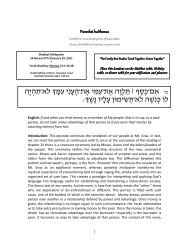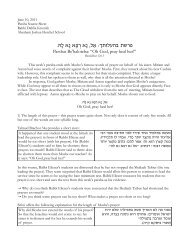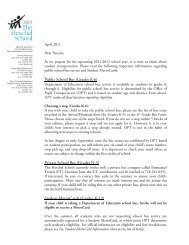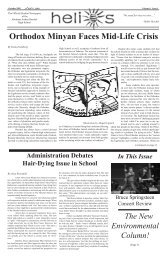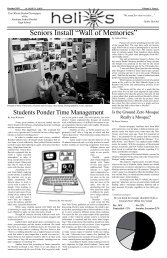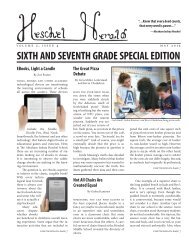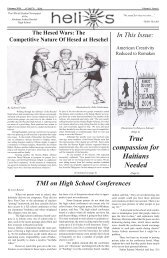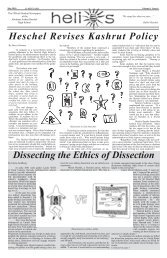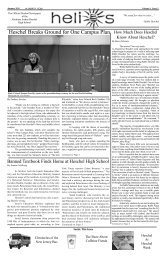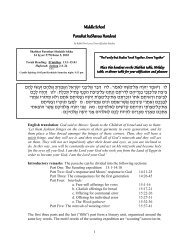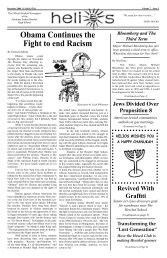Volume 1, Issue 5 (June 2011) - The Heschel School
Volume 1, Issue 5 (June 2011) - The Heschel School
Volume 1, Issue 5 (June 2011) - The Heschel School
You also want an ePaper? Increase the reach of your titles
YUMPU automatically turns print PDFs into web optimized ePapers that Google loves.
Washington, DC and Philadelphia<br />
DC Trip—National Gallery<br />
By Ariella Kahan<br />
On the last day of the Washington<br />
D.C. trip, the seventh graders went to the<br />
National Gallery. <strong>The</strong> National Gallery<br />
is an extraordinary art museum with<br />
an exceptional collection of art from the<br />
Renaissance. <strong>The</strong> seventh grade focused<br />
on Renaissance art during their tours of<br />
the museum to augment their humanities<br />
study of the Renaissance.<br />
In the National Gallery, the grade<br />
was split into four groups based on their<br />
advisory. For an hour, each group was<br />
led by a tour guide through the museum<br />
and learned about<br />
a variety of paintings.<br />
<strong>The</strong> paintings<br />
were by Botticelli,<br />
Leonardo da Vinci,<br />
Bellini, Titian<br />
and many other<br />
great artists. Some<br />
paintings that the<br />
seventh grade saw<br />
were: Ginevra de’<br />
Benci, <strong>The</strong> Adoration<br />
of the Magi, both by Leonardo<br />
da Vinci and many others. Many of the<br />
paintings had Christian themes, but one<br />
unique painting depicted a story from<br />
the Torah. This was exciting to many<br />
students because after seeing numerous<br />
paintings of the Madonna and the Saints,<br />
it was exciting to see that the Torah was<br />
also a subject of art during the Renaissance.<br />
Additionally, it was great to connect<br />
what we saw in the museum to our<br />
studies in class. As one seventh grader<br />
said, “It was very exciting to see the<br />
paintings of artists we have been learning<br />
about all year. We saw paintings of<br />
Botticelli, and we read Primavera which<br />
was based on the painting ‘Primavera’ by<br />
Botticelli.”<br />
Two of the four tour guides were<br />
very good, and made the experience at<br />
the National Gallery a favorite of many<br />
students, but unfortunately the other<br />
two tour guides were not as good. Because<br />
of this, the National Gallery got<br />
mixed reviews. Some students called it,<br />
“amazing,” and said it was the best part<br />
of their trip. Other students did not like<br />
it as much, and were disappointed in<br />
the museum. One seventh grader said,<br />
“It was one of the<br />
best museums<br />
of the trip!” Another<br />
said, “it was<br />
very interesting<br />
and we learned<br />
about some of<br />
the Ancient gods<br />
and also about a<br />
famous painter<br />
named Titian.<br />
overall the paintings<br />
were beautiful and articulate.” Although<br />
many reviews of the museum<br />
were very positive, other students were<br />
not as favorable about the National Gallery.<br />
Some students thought they were<br />
too tired to enjoy the museum, and<br />
others thought the tour guide was boring.<br />
Despite the negative reviews, many<br />
students agreed that all around, the<br />
museum was both fun and interesting.<br />
However, many seventh graders hope<br />
the sixth grade will have better luck with<br />
their tour guides next year! ◆<br />
We May Look Different<br />
By Hallie Fawer and Noah Shapiro<br />
On May 4, <strong>2011</strong>, the sixth grade went to<br />
the Amish country in Lancaster, Philadelphia<br />
with Shoshana Jebwab, Marilyn<br />
Tawil, Paulette Cohen, David Frankle,<br />
and Donna Aber. After they saw the<br />
film “Jacob’s Choice,” a brief film that<br />
explained certain Amish traditions, they<br />
explored a model of an Amish one-room<br />
schoolhouse, and then visited an Amish<br />
farmer’s house. Once students were inside<br />
and seated, Sam Riehl, the farmer,<br />
welcomed everyone. He reminded students<br />
that every culture has different<br />
beliefs, and that they may look different<br />
but they, like everyone, “are still just human<br />
beings on earth.”<br />
As a matter of fact, a lot of people<br />
thought that the Amish’s homes would<br />
look different from ours. To most people’s<br />
surprise, there were few differences.<br />
A sixth grader commented, “<strong>The</strong>ir houses<br />
looked exactly like ours, except there<br />
were no electric lights, televisions, or<br />
computers. Though everyone noted that<br />
their clothes were different than ours, no<br />
one really focused on that, but instead,<br />
focused on the fact that their activities<br />
were different. Instead of sitting on a<br />
couch with their eyes glued to their electronics,<br />
they were doing farm work, and<br />
even the younger children helped.”<br />
Amish farmer Sam Riehl also explained<br />
to the sixth graders about the<br />
tradition of “Rumspringa,” which is defined<br />
in German as, “running around.”<br />
This refers to a period that begins at<br />
Continued on page 10<br />
Holocaust Museum Exhibit:<br />
“State Of Deception”<br />
by Nico Miller<br />
<strong>The</strong> seventh grade traveled to<br />
Washington DC on May 5. While there,<br />
they went to an exhibit in the Holocaust<br />
Museum about Nazi propaganda, called<br />
“State of Deception.” When students first<br />
walked into the exhibit, the sound of<br />
Nazi marching music and the sight of<br />
bright colored posters instantly bombarded<br />
them. <strong>The</strong>se posters depicted<br />
a “happy” group of young people who<br />
were going to save the world by getting<br />
rid of the Jews. <strong>The</strong>re was no mention<br />
of the Nazis’ assault on Europe or anything<br />
negative. <strong>The</strong> exhibit’s design was<br />
intended to make the viewer feel happy<br />
and safe.<br />
If the viewer did not know that this<br />
exhibit was about something horrifying<br />
like the Holocaust, he would have<br />
thought that Hitler was doing something<br />
good. It was clear how powerful<br />
propaganda is, and how easy it is to get<br />
manipulated by it. First of all, the joyous<br />
marching music brought a happy<br />
atmosphere to the room. Next, there<br />
were posters depicting people smiling<br />
Continued on page 10<br />
6 ◆ <strong>Heschel</strong> Herald, <strong>Volume</strong> 1, <strong>Issue</strong> 5 <strong>The</strong> Abraham Joshua <strong>Heschel</strong> <strong>School</strong>



